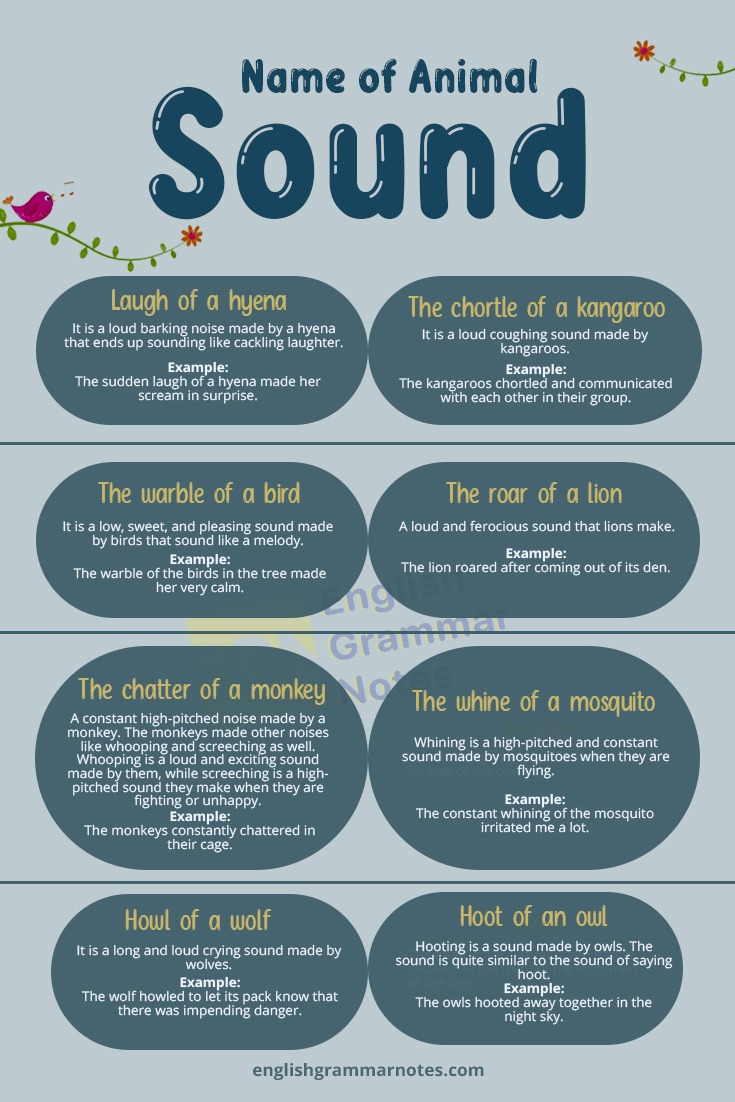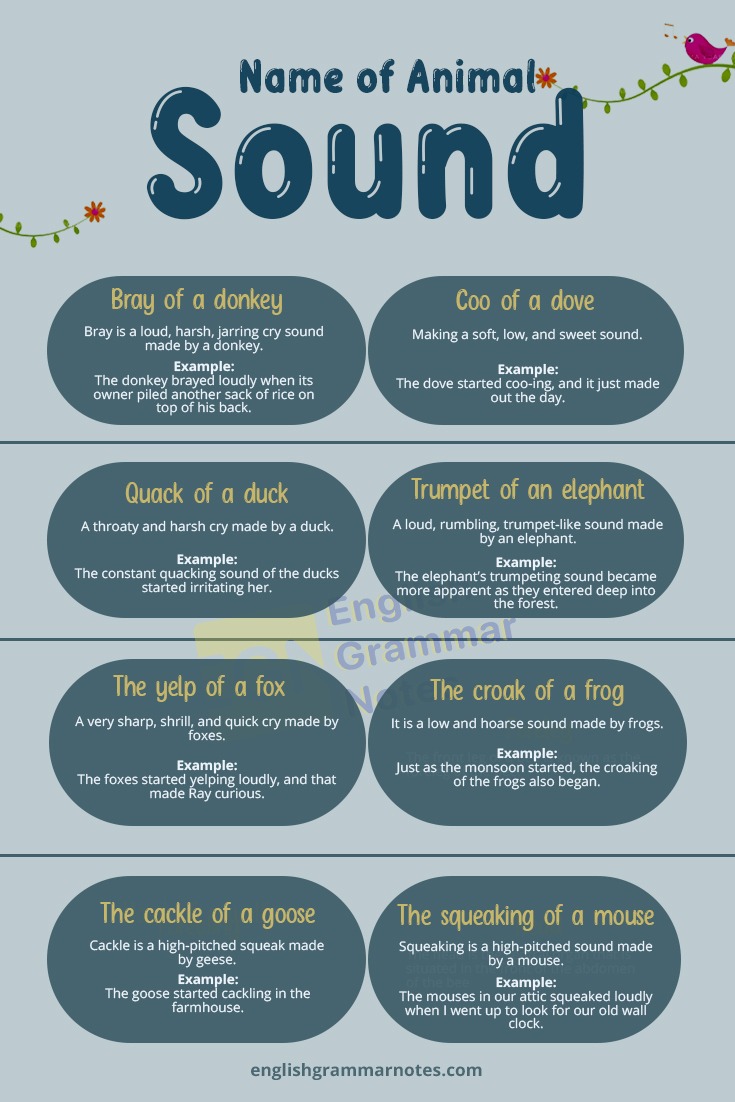Animal Sounds: If you are an experienced native English language speaker or maybe are in the learning process, you are bound to come across certain animal sounds. Numerous animals are living on our planet. of them has a different and unique sound that makes them distinct from each other.
Since there are numerous animals, there are multiple animal sounds as well. There are wild animals sounds, bird sounds, domestic animals sound, and many more. It becomes pretty difficult to remember each sound and the name of the animal that made the sound. Hence, for your easy remembrance, we have made a list of animal sounds that include different sounds of animals and the names of the animals that made the sound.
Study the most important English Vocabulary Words identified by our experts and learn the right vocabulary to use in your day to day conversations
- List of animals sounds
- Meanings and Examples on the Animal sounds on the list
List of animals sounds
- Laugh of a hyena
- The chortle of a kangaroo
- The warble of a bird
- The roar of a lion
- The chatter of a monkey
- The whine of a mosquito
- Howl of a wolf
- Hoot of an owl
- Bray of a donkey
- Coo of a dove
- Quack of a duck
- Trumpet of an elephant
- The yelp of a fox
- The squeaking of a mouse
- Moo of a cow
- Bellow of a bull
- Cluck of a chicken
- Click of a dolphin
- Scream of a chimpanzee
- Cheep of a chick
- Cock-a-doodle-do of a rooster
- The chirp of a cricket
- Caw of a crow
- The bark of a dog
- Oink of a pig
- The neigh of a horse
- Whisper of a man
- The whistle of a bird
- The squeak of a rabbit
- The bark of a seal
- Gobble of a turkey
- The squawk of a parrot
- Screeching of a bat
- Growling of a bear
- The bleating of a lamb
- Grunting of a camel
- The meowing of a cat
- The croak of a frog
Meanings and Examples on the Animal sounds on the list
Laugh of a hyena
Meaning: It is a loud barking noise made by a hyena that ends up sounding like cackling laughter.
Example: The sudden laugh of a hyena made her scream in surprise.
The chortle of a kangaroo
Meaning: It is a loud coughing sound made by kangaroos.
Example: The kangaroos chortled and communicated with each other in their group.
The warble of a bird
Meaning: It is a low, sweet, and pleasing sound made by birds that sound like a melody.
Example: The warble of the birds in the tree made her very calm.
The roar of a lion
Meaning: A loud and ferocious sound that lions make.
Example: The lion roared after coming out of its den.
The chatter of a monkey
Meaning: A constant high-pitched noise made by a monkey. The monkeys made other noises like whooping and screeching as well.
Whooping is a loud and exciting sound made by them, while screeching is a high-pitched sound they make when they are fighting or unhappy.
Example: The monkeys constantly chattered in their cage.
The whine of a mosquito
Meaning: Whining is a high-pitched and constant sound made by mosquitoes when they are flying.
Example: The constant whining of the mosquito irritated me a lot.
Howl of a wolf
Meaning: It is a long and loud crying sound made by wolves.
Example: The wolf howled to let its pack know that there was impending danger.
Hoot of an owl
Meaning: Hooting is a sound made by owls. The sound is quite similar to the sound of saying hoot.
Example: The owls hooted away together in the night sky.
Bray of a donkey
Meaning: Bray is a loud, harsh, jarring cry sound made by a donkey.
Example: The donkey brayed loudly when its owner piled another sack of rice on top of his back.
Coo of a dove
Meaning: Making a soft, low, and sweet sound.
Example: The dove started coo-ing, and it just made out the day.
Quack of a duck
Meaning: A throaty and harsh cry made by a duck.
Example: The constant quacking sound of the ducks started irritating her.
Trumpet of an elephant
Meaning: A loud, rumbling, trumpet-like sound made by an elephant.
Example: The elephant’s trumpeting sound became more apparent as they entered deep into the forest.
The yelp of a fox
Meaning: A very sharp, shrill, and quick cry made by foxes.
Example: The foxes started yelping loudly, and that made Ray curious.
The croak of a frog
Meaning: It is a low and hoarse sound made by frogs.
Example: Just as the monsoon started, the croaking of the frogs also began.
The cackle of a goose
Meaning: Cackle is a high-pitched squeak made by geese.
Example: The goose started cackling in the farmhouse.
The squeaking of a mouse
Meaning: Squeaking is a high-pitched sound made by a mouse.
Example: The mouses in our attic squeaked loudly when I went up to look for our old wall clock.
Moo of a cow
Meaning: The low and deep vocal sound made by a cow.
Example: The herd of cows mooed while grazing the grasses on the field.
Bellow of a bull
Meaning: A loud, roaring, and angry sound that is made by a bull.
Example: The bull bellowed and started running once it saw the red cloth.
Cluck of a chicken
Meaning: A deep, short, and sharp sound made by chickens.
Example: The group of chickens started clucking together, and the noise made her head hurt.
Click of a dolphin
Meaning: Click is a sound made by dolphins to sense their surroundings with the help of echolocation.
Example: The group of dolphins sends out rapid clicks using their nasal sacs.
Scream of a chimpanzee
Meaning: It is a high-pitched, loud sound made by chimpanzees when they are fighting or when they need help.
Example: Oscar, the chimpanzee, screamed when his food was snatched away by another chimpanzee.
Cheep of a chick
Meaning: The cheep is a high-pitched shrill sound made usually by all baby birds.
Example: The baby chick cheeped after his mother.
Cock-a-doodle-do of a rooster
Meaning: A long call made by a rooster.
Example: The rooster in our neighbourhood cries cock-a-doodle-do every morning and wakes us up.
The chirp of a cricket
Meaning: A short high-pitched sound made by crickets.
Example: The crickets in our garden chirp every day as soon as it has grown dark.
Caw of a crow
Meaning: The caw is a loud and harsh cry made by crows.
Example: The crow kept on cawing until we gave it a biscuit to eat.
The bark of a dog
Meaning: It is a loud, short, and sharp sound made by dogs when they are frightened, surprised, or annoyed. They also make a woof sound when they are playful.
Example: Our dog Lily started barking as soon as she saw strangers in our house.
Oink of a pig
Meaning: It is a grunting sound made by pigs.
Example: The pigs in our farm always oinked.
The neigh of a horse
Meaning: Neighing is a prolonged cry made by horses. They even make sounds like snorts and whinnies.
Example: The horses neighed in the stable when Georgia stroked their head.
Whisper of a man
Meaning: Whisper means to speak very softly and quietly.
Example: Violet leaned over and whispered something in her boyfriend’s ear.
The whistle of a bird
Meaning: An unmistakable, high-pitched musical sound made by birds.
Example: The whistling of the birds was highly musical.
The squeak of a rabbit
Meaning: Squeaking is a whimpering sound made by rabbits.
Example: The rabbit kept on squeaking loudly to warn the other rabbits of the danger.
The bark of a seal
Meaning: It is a sound made by seals with the help of their throat and air.
Example: The barking of the seals was becoming quite faint.
Gobble of a turkey
Meaning: A rapid and loud gurgling noise made by turkeys.
Example: The wild turkey gobbled loudly as soon as it entered the other part of the forest.
The squawk of a parrot
Meaning: A very harsh and screeching noise made by a parrot.
Example: My parrot kept squawking until I gave her something to eat.
Screeching of a bat
Meaning: A shrill and high-pitched sound made by bats.
Example: The bats started screeching and flying as soon as they entered the cave.
Growling of a bear
Meaning: Growling is a low, guttural sound made by bears. It can sometimes be aggressive, but usually, it is a non-aggressive sound.
Example: The bear angrily growled at the group of tourists.
Buzzing of a bee
Meaning: A rapid and vibrating humming sound that is made by bees. It is also known as humming.
Example: The bees were constantly buzzing around our picnic table.
The bleating of a lamb
Meaning: The cry of a lamb is known as bleating. It is a sound that is made by goats and calves as well.
Example: When she heard the faint bleating of the lambs, she understood that this indeed was the right way to her farmhouse.
Grunting of a camel
Meaning: It is a low and deep sound made by camels.
Example: The mother camel grunted at her children
The meowing of a cat
Meaning: A characteristic crying sound made by cats, usually when they are hungry. Cats also make other sounds like purr and mew.
Purr is a vibratory sound that expresses contentment, while mew is a high-pitched cry sound.
Example: Maya’s cat stopped meowing when he got his bowl of milk.
Vocabulary — List of Animal Sounds
This is a list of vocabulary related to sounds of animals
| Animals | Sounds |
|---|---|
| Apes | gibber |
| Bats | screech |
| Bears | growl |
| Bees | hum and buzz |
| Birds | chirrup, chirp, twitter, tweet, sing, whistle |
| Calves | bleat |
| Camels | grunt |
| Cats | mew, purr, meow, hiss, yowl |
| Cattle | moo, low, bawl (calf), bellow (bull) |
| Chicks | cheep |
| Chickens | cluck, cackle |
| Cocks | crow |
| Cows | low, moo |
| Crickets | chirp, creak |
| Crows | caw |
| Deers | bell |
| Dogs | bark |
| Dolphins | click |
| Donkeys | bray |
| Doves | coo |
| Ducks | quack |
| Eagles | scream |
| Elephants | trumpet, roar |
| Flies | buzz, hum |
| Foxes | bark, yelp, simper |
| Frogs | croak |
| Giraffes | bleat |
| Goats | bleat |
| Geese | cackle, quack |
| Grasshoppers | chirp |
| Hamsters | squeak |
| Hares | squeak |
| Hens | cackle, cluck |
| Humans | whisper, whistle, cry, scream, sing, talk |
| Hogs | grunt |
| Horses | neigh, snort, whinny, nicker |
| Hummingbirds | hum |
| Hyenas | laugh, scream |
| Jackals | howl |
| Kangaroos | chortle |
| Koalas | scream, bellow, wail |
| Lambs | bleat |
| Larks | sing, warble |
| Lions | roar, growl |
| Mice | squeak and squeal |
| Monkeys | chatter, gibber, whoop, screech |
| Mosquitoes | whine |
| Nightingales | pipe, sing, warble |
| Ostriches | chirp, bark, hiss, low hum |
| Owls | hoot, scream, screech, shriek |
| Oxen | bellow, low |
| Parrots | talk, screech, squawk |
| Peacocks | scream |
| Pigs | snort, grunt, squeal, oink |
| Pigeons | coo |
| Rabbits | squeak, drum |
| Rats | squeak |
| Ravens | croak |
| Rhinoceros | bellow |
| Rooster | crow |
| Seagulls | scream, squawk |
| Seals | bark |
| Sheep | bleat |
| Snakes | hiss |
| Tigers | growl, roar |
| Turkeys | gobble |
| Vultures | scream |
| Whales | sing |
| Wolves | howl, cry, yell |
| Zebras | whinny |
See a longer list of animal sounds
Quick Links
Awesome Links You May Like
-
A List of Idiomatic Expressions
What are idioms? And how can idioms help you become a fluent speaker? Discover a list of the most widely used idiomatic expressions!
-
A list of Phrasal Verbs
Phrasal verbs are generally used in spoken English and informal texts. Check out our list of hundreds of phrasal verbs classified in alphabetical order.
-
A list of figures of speech
Do you want to provide emphasis, freshness of expression, or clarity to your writing? Check out this list of figures of speech!
-
A list of irregular verbs
Do you need to learn the irregular verbs in English? Here is a list of irregular verbs with definitions and examples!
NEWSLETTER
Subscribe and get the latest news and useful tips, advice and best offer.
Skip to content
Here is Animal Sounds List. This is a list of words used in the English language to represent the noises of particular animals, especially noises used by animals for communication. Words on the list are in the form of verbs, though many can also be used as nouns or interjections, including many onomatopoeia.
The following is a list of sound words that denote animal sounds and bird cries. It also contains a list of words that denote the sounds produced by inanimate objects and sounds in nature. Search a word to find more about the sounds of animals and birds.
There are currently 73 names in this directory
Cats
mew, purr, meow, hiss, yowl
Cattle
moo, low, bawl (calf), bellow (bull)
Horses
neigh, snort, whinny, nicker
Humans
whisper, whistle, cry, scream, sing, talk
Koalas
scream, bellow, wail
Monkeys
chatter, gibber, whoop, screech
Nightingales
pipe, sing, warble
Ostriches
chirp, bark, hiss, low hum
Owls
hoot, scream, screech, shriek
Parrots
talk, screech, squawk
Pigs
snort, grunt, squeal, oink
Related Posts
From Wikipedia, the free encyclopedia
Certain words in the English language represent animal sounds: the noises and vocalizations of particular animals, especially noises used by animals for communication. The words can be used as verbs or interjections in addition to nouns, and many of them are also specifically onomatopoeic.
List of animal sounds[edit]
| Picture | Animal | Description | Sound | |
|---|---|---|---|---|

|
Alligator | bellow, hiss |
Alligator bellow |
|

|
Alpaca | alarm call, cluck/click, hum, orgle, scream[1] | ||

|
Antelope | snort[2] | ||

|
Badger | growl[3] |
Badger |
|

|
Bat | screech,[4] squeak |
Bats |
|

|
Bear | roar, growl |
Bear cub growl |
|
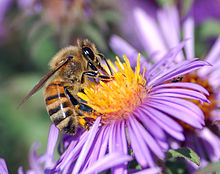
|
Bee | buzz |
Hummel bee Xylocopa pubescens (carpenter bee) offsprings |
|

|
Big cat (Tiger, Lion, Jaguar, Leopard) | roar,[5] growl,[6] snarl[7] |
Tiger growl Jaguar making a content «sawing» sound. |
|
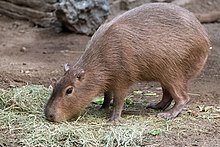
|
Capybara | squeak,[8] chatter, bark | ||

|
Cat | mew, meow, purr, hiss, trill, caterwaul, growl |
Cat meow Domestic cat purring |
|

|
Cattle | moo, low | ||
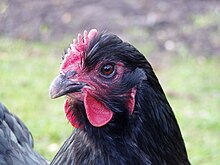
|
Chicken | cluck, buck, crow[9] cha-caw, bah-gawk (female)[10] cock-a-doodle-doo (male) |
||

|
Chinchilla | squeak[11] | ||

|
Cicada | chirp[12] |
Cicada |
|

|
Crab | chirp, click, creak[13] | ||
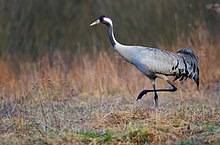
|
Crane | clang | ||

|
Cricket | chirp |
Cricket |
|
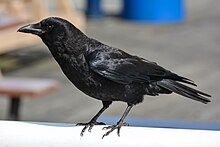
|
Crow | caw, cah[14] |
Black Crow |
|
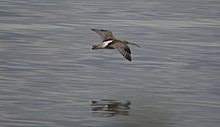
|
Curlew | pipe[15] | ||
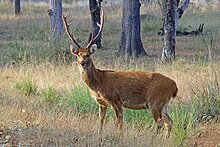
|
Deer | bellow (buck), bleat (doe, fawn) |
Red deer |
|

|
Dog | bark, howl, growl, bay |
Dog bark |
|

|
Dolphin | click[16] | ||

|
Donkey | hee-haw,[17] bray |
Domestic donkey brays |
|

|
Duck | quack |
Mallard Duck |
|

|
Eagle | screech[18] |
Bald Eagle |
|

|
Elephant | trumpet |
Elephant trumpet |
|

|
Elk | bugle (male),[19] bleat (calves)[20] |
Elk bellow |
|
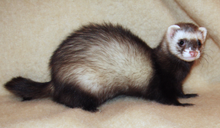
|
Ferret | dook[21] | ||

|
Fly | buzz | ||

|
Fox | bark, scream, howl, snore, gecker[22] | ||

|
Frog | croak, ribbit |
Common Toad |
|

|
Gaur | low, moo | ||

|
Giraffe | bleat,[23] hum[24] |
Giraffe hum |
|
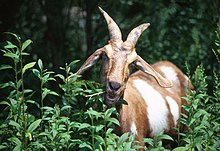
|
Goat | bleat, maa |
Herd of goats bleating |
|
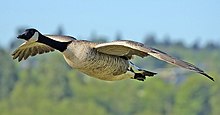
|
Goose | honk, hiss |
Geese Honking |
|
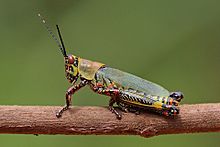
|
Grasshopper | chirp[25] |
Grasshoppers chirping |
|

|
Guinea pig | wheek[26] | ||

|
Hamster | squeak[27] | ||
|
|
Hawk | screech |
Hawk screeching |
|

|
Hermit crab | chirp[28] | ||

|
Hippopotamus | growl[29] | ||
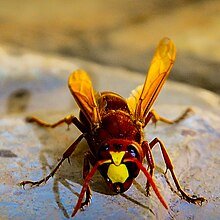
|
Hornet | buzz |
Hummel bee |
|

|
Horse | neigh, whinny, nicker | ||
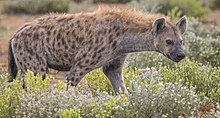
|
Hyena | laugh |
Spotted Hyena |
|
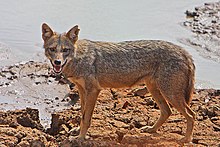
|
Jackal | gecker[6] | ||

|
Koala | bellow, shriek | ||

|
Lemur | chatter, whoop | ||
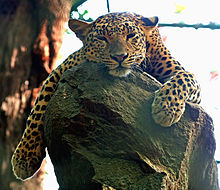
|
Leopard | roar, growl, snarl | ||

|
Linnet | chuckle[30] | ||

|
Lion | roar, growl, snarl |
Lion roar |
|
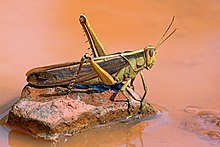
|
Locust | chirp[25] | ||

|
Magpie | chatter[31] |
Magpie |
|

|
Monkey | scream, chatter, gecker,[6] howl |
Mantled Howler Monkey (Alouatta palliata) |
|
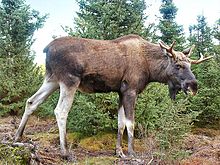
|
Moose | bellow[32] | ||

|
Mosquito | buzz, whine | ||

|
Mouse | squeak | ||

|
Okapi | cough, bellow[33] | ||
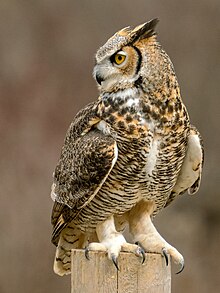
|
Owl | hoot, hiss, caterwaul for barred owls |
Great horned owl |
|

|
Ox | low, moo | ||

|
Parrot | squawk, talk |
White-capped Parrot Rose-ringed Parakeet imitating human speech |
|
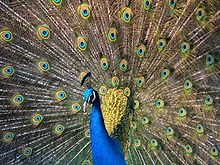
|
Peacock | scream,[34] squawk, honk |
Peacock |
|

|
Pig | oink,[29][35] snort,[36] squeal, grunt |
Pig |
|

|
Pigeon | coo |
Wood pigeon |
|

|
Prairie dog | bark[37] | ||

|
Quail | call |
Call of a male common quail |
|
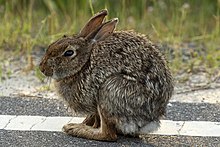
|
Rabbit | squeak |
Rabbit |
|

|
Raccoon | trill[38] |
Baby Raccoon Chatter |
|

|
Rat | squeak | ||

|
Raven | caw |
Common Raven |
|

|
River otter | blow, chatter, chirp, creek, grunt, hiccup, hiss, scream, squeak, swish, whine, whistle,[39] chatterchirp,[40] purr[41] | ||

|
Rook | caw | ||

|
Seal | bark[42] | ||

|
Sheep | bleat |
Sheep |
|

|
Snake | hiss, rattle |
Rattlesnake |
|
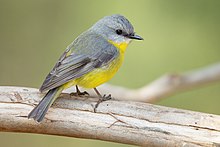
|
Songbird | chirrup, chirp, tweet, sing, warble (larks / warblers / wrens),[43][44] twitter (sparrows)[45] |
Goldfinch |
|

|
Squirrel | squeak | ||

|
Swan | cry, trumpet, bugle |
Trumpeter swan |
|

|
Tapir | squeak[46] | ||

|
Tokay gecko | croak[47] |
Tokay gecko mating call |
|

|
Turkey | gobble |
Wild Turkey |
|

|
Whale | sing |
Humpback whale |
|
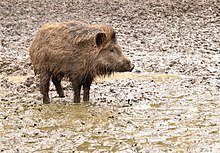
|
Wild boar | growl, grumble |
Wild boar |
|

|
Wildebeest | low, moo | ||

|
Wolf | howl, growl, bay |
Wolf howls |
|

|
Zebra | bray, bark, whistle, yip, nicker |
See also[edit]
- Animal communication
- Animal epithet
- Animal language
- Bioacoustics
- Cat organ & piganino
- Cross-linguistic onomatopoeias
- Field recording
- List of animal names
- List of onomatopoeias
- «Old MacDonald Had a Farm»
- «The Fox (What Does the Fox Say?)»
References[edit]
- ^ «Important Question: What Sound Does An Alpaca Make?». Modern Farmer. Retrieved 29 October 2021.
- ^ Caro, Tim (2005). Antipredator Defenses in Birds and Mammals. University of Chicago Press. p. 250. ISBN 9780226094366.
- ^ Schwartz, Charles Walsh; Schwartz, Elizabeth Reeder (2001). The Wild Mammals of Missouri (2nd revised ed.). University of Missouri Press. p. 316. ISBN 9780826213594.
- ^ Boughman, Janette Wenrick; Wilkinson, Gerald S. (1999). «Social Influences on Foraging in Bats». Mammalian Social Learning: Comparative and Ecological Perspectives. University of Cambridge Press (72): 195.
- ^ «Big Cat Facts». Animal Facts Encyclopedia. Copyright by Jenise Alongi. Retrieved March 17, 2016.
- ^ a b c Estes, Richard (1991). The Behavior Guide to African Mammals: Including Hoofed Mammals, Carnivores, Primates. University of California Press. p. 374. ISBN 9780520080850.
- ^ Schaller, George B. (1967). The Deer and the Tiger. University of Chicago Press. p. 261. ISBN 9780226736570.
- ^ Barros, Kamila S.; Tokumaru, Rosana S.; Pedroza, Janine P.; Nogueira, Selene S. C. (2010-11-22). «Vocal Repertoire of Captive Capybara (Hydrochoerus hydrochaeris): Structure, Context and Function». Ethology. 117 (1): 83–94. doi:10.1111/j.1439-0310.2010.01853.x. ISSN 0179-1613.
- ^ Why Do Roosters Crow?: First Questions and Answers about Farms. Time-Life for Children. 1995. ISBN 9780783508993.
- ^ Caughey, Melissa (2015). A Kid’s Guide to Keeping Chickens: Best Breeds, Creating a Home, Care and Handling, Outdoor Fun, Crafts and Treats. Storey Publishing. p. 90
- ^ Winter, Lisa. The Ultimate Guide To Chinchilla Care. Simple Sequence Books. p. 24.
- ^ Power, Carla (September 4, 2000). «Ruins with A View». Newsweek International: 24.
- ^ «What sound does a crab make?». Answers. Retrieved October 17, 2020.
- ^ Holmes, Hannah (2005). Suburban Safari: A Year on the Lawn. Bloomsbury. p. 10. ISBN 9781596918115.
- ^ White, Gilbert (1837). The natural history and antiquities of Selborne. With The naturalist’s calendar and miscellaneous observations. p. 449.
- ^ Wilson, Ben (1998). Dolphins of the World. Voyager Press. p. 29. ISBN 9780896585362.
- ^ Metz, Lorijo (2011). Donkeys: Jennies, Jacks, and Foals. The Rosen Publishing Group. p. 10. ISBN 9781448806881.
- ^ «Caught in the Act — to Capture Bald Eagles on Film, a Husband-and-Wife Team Has Spent Years Perfecting the Art of Anticipation». National Wildlife. 39 (2): 24. February–March 2001.
- ^ Thomas, Jack Ward; Toweill, Dale (2002). Elk of North America, Ecology and Management. New York: HarperCollins. ISBN 0-8117-0571-4.
- ^ Ballard, Jack (2012). Elk: A Falcon Field Guide. Morris Book Publishing. p. 47. ISBN 9780762776269.
Elk vocalizations aren’t reserved just for the bulls. Cows and … Calves may respond to the cow calls with their own low bleats. When large ..
- ^ Mathis, Christine; Morton, E. Lynn (2010). Ferrets. Barron’s. p. 87. ISBN 9780764143328.
- ^ «What does the red fox say?». Popular Science. 2019-01-07. Retrieved 2021-10-28.
- ^ Silverstein, Alvin; Silverstein, Virginia (1980). Nature’s Champions: The Biggest, the Fastest, the Best. Random House. p. 19. ISBN 9780486428888.
- ^ Baotic, A.; Sicks, F.; Stoeger, A. S. (2015). «Nocturnal «humming» vocalizations: adding a piece to the puzzle of giraffe vocal communication». BMC Research Notes. 8: 425. doi:10.1186/s13104-015-1394-3. PMC 4565008. PMID 26353836.
- ^ a b Heinrichs, Anna (2002). Grasshoppers. Compass Point Books. p. 4. ISBN 9780756501662.
- ^ Gunter, Veronika Alica; Newcomb, Rain (2006). Pet Science: 50 Purr-fectly Woof-worthy Activities for You & Your Pets. Lark Books. p. 21. ISBN 9781579907860.
- ^ Bartlett, Patricia Pope (2003). The Hamster Handbook. Barron’s. p. 37. ISBN 9780764122941.
- ^ Wilkins, Kelli A. (2007). Hermit Crabs For Dummies. Wiley Publishing. ISBN 9781118068267.
- ^ a b Symons, Mitchell (2012). The Bumper Book For The Loo: Facts and figures, stats and stories – an unputdownable treat of trivia. Random House. p. 364. ISBN 9781448152711.
- ^ Le Clerc, Georges Louis (1793). The natural history of birds, from the Fr. of the count de Buffon. p. 54.
- ^ Birkhead, Tim (1991). The Magpies: The Ecology and Behaviour of Black-Billed and Yellow-Billed Magpies. T & AD Poyser. p. 250. ISBN 9781408137772.
- ^ «Moose». International Wildlife Encyclopedia. Marshall Cavendish. 2002. p. 1656.
- ^ Lindsey, Susan Lyndaker; Green, Mary Neel; Bennett, Cynthia L. (1999). The Okapi: Mysterious Animal of Congo-Zaire. University of Texas Press. p. 34. ISBN 9780292788329.
- ^ Attarde, I. P. (2007). Encyclopedic Graded Grammar. Vol. 1. LULU. p. 25. ISBN 9781435707177.
- ^ «Oink.» Merriam-Webster. 26-01-2016.
- ^ QA International Collectif (1999). So Many Ways to Communicate — A new way to explore the animal kingdom. Québec Amerique. p. 29. ISBN 9782764409213.
- ^ Valerie V. Tynes, ed. (2010). Behavior of Exotic Pets. Blackwell. p. 149. ISBN 9781118710135.
- ^ Siegel, Mordecai (2004). The Cat Fanciers’ Association Complete Cat Book. HarperCollins. p. 136. ISBN 9780062030399.
- ^ Almonte, Carla (November 2014). «Classification of Captive North American River Otters (Lontra canadensis) Vocal Repertoires: Individual Variations, and Age Class Comparisons». doi:10.12966/abc.11.07.2014. Retrieved 12 November 2022.
- ^ Walkley, Sarah (Spring 2018). «Vocalizations of North American River Otters (Lontra canadensis) in Two Human Care Populations». Retrieved 12 November 2022.
- ^ Pesaturo, Janet. «River Otter Vocalizations: the Purr». Winterberry Wildlife. Retrieved 12 November 2022.
- ^ McCausland, Jim (May 2005). «Hood Canal Hideaway: Between Seattle and the Olympics, an Unsung Getaway Just Got Better». Sunset. 214 (5): 64+.
- ^ Rao, S. N. (2004). Strengthen Your English. V. V. K. Subburaj. p. 26. ISBN 9788172540531.
- ^ Stallcup, Rich (1993). Birds of California: A Guide to Viewing Distinctive Varieties. American Traveler. p. 38. ISBN 9781558381322.
- ^ Sharma, S. D. (2007). A Text Book of Scientific and Technical Communication Writing for Engineers and Professionals (3rd ed.). Sarup & Sons. p. 365. ISBN 9788176257510.
- ^ Endangered Wildlife and Plants of the World. Marshall Cavendish. 2001. p. 1460. ISBN 9780761471943.
- ^ Perez, Larry (2012). Snake in the Grass: An Everglades Invasion. Pineapple Press. p. 55. ISBN 9781561645138.
External links[edit]
- List of animal sounds to download, listen and use for free.
- Multilingual list of animal sounds Derek Abbott, University of Adelaide
It is amazing how different people around the world hear the sounds of the same animals. I always find this fascinating at least. Since I have been talking about onomatopoeia in the last few posts I thought I would share with you the way the sounds of some different animals are heard and written in English. Some of these are a little different from the verbs used to describe these sound, which I listed yesterday. I have noted the words below that cannot be used (or usually are not used) as verbs with an asterisks (*). All the other words can be turned into verbs and conjugated. I have also included a video below of a children’s song that you can listen to in order to hear how all of these examples of onomatopoeia sound. Something else to note about writing animal sounds in English is that often the words are written with repeated letters to emphasize the sounds, for example: buzz (the sounds many insects make) may be written as “buzzzzzzzzzzzz” or moo (the sound a cow makes) may be written as “mooooooooo”. Also some animal sounds are written twice connected by a hyphen, for example: cluck-cluck (the sound a chicken makes). I have noted the most common examples of this below.
I would love if you left a comment on this post telling us all how people hear these same animal sounds differently in the language you speak. 🙂
Below I have written the animal’s name, with its sound(s) after the colon. Remember words with * should not be made into verbs.
bee: buzz (also written bzz)
bear: grrr*, growl
birds: cheep-cheep*, chirp, tweet*, squawk
cats: meow, purr
chicken: cluck (or cluck-cluck)
cow: moo
dog: arf*, woof* (or woof-woof), ruff* (or ruff-ruff), bow wow*, bark
dove: coo
donkey: hee-haw
duck: quack (or quack-quack)
frog: croak, ribbit (or ribbit-ribbit)
horse: neigh
sheep or goat: baa*
pig: oink (or oink-oink)
mouse: squeak (or squeak-squeak)
owl: whoo-whoo
rooster: cock-a-doodle-doo*
snake: hiss
tiger: grrr*, raaa*, growl, roar
turkey: gobble (or gobble-gobble)
wolves: ou ou ouooooo*, howl

